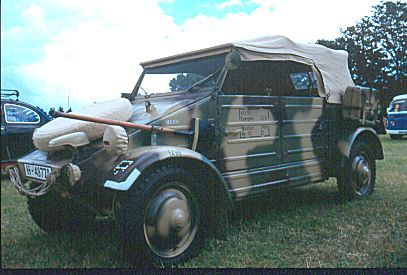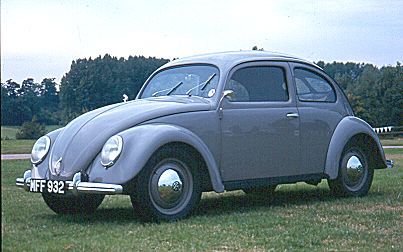Volkswagens in the UK
Chapter 1 - The Nineteen Forties
1940 something
One of the very best of the VW shows held each year is 'Peppercorn', not far from Maidstone in Kent. Thanks to its proximity to the channel, not only do the British enthusiasts flockKubelwagen seen at Peppercorn VW Meet in 2002. to it, so do quite a number from across the waters. The range of vintage VWs on show has to be seen to be believed. This is the show where 'Our Ken' is likely to photograph more vehicles than anywhere else. Sadly, there are so many to choose from that some escape the Box Brownie's clutches, as was the case with this Kübelwagen in 2002. For all fans, the pre-war days of the KdF-Wagen and Ferdinand Porsche's many successful attempts to adapt his beloved Beetle for military usage provide a fascinating backdrop to the VW story of later years. Dr Simon Parkinson, a former Editor of the Historic Volkswagen Club's magazine, wrote a book entitled 'Volkswagen Beetle: The Rise from the Ashes of War' in which he alluded to the birth and development of the Kübelwagen. Porsche was commissioned by Hitler and not the military to build the vehicle and the first examples came off the production lines in 1940. Thanks to contractual reasons, the bodies were built and painted in Berlin by the American owned company of Ambi-Budd, before despatch to the KdF works, where they were mated to the chassis. Officially designated as the Type 82, the nickname Kübelwagen, literally 'bucket car' stuck, partly due to its bucket-like seats and rather obviously as a result of its shape.

1949
John Maxwell first glimpsed the car that was to become his first-love in March 1996. With assistance from the Stiftung Automuseum in Wolfsburg he ascertained before purchase that the car had been built on June 11th 1949. Plans were put in place immediately to wrest it from its Swedish home and bring it to England. The car is something of an anomaly in that it was constructed before the launch of the Export or Deluxe model with its comparatively luxurious fittings and yet it features some chrome, hardly consistent with all but a few Beetles built in the early days. The truth of the matter appears to be that here was one of the slightly upgraded cars, an idea dating from the days of British control, destined for export. John's protracted and sensitive restoration involving many man-hours and effected almost entirely by him, has resulted in a car that would be entirely appropriate to any museum collection where accuracy of presentation was the key. The car is finished in Pearl Grey, L21. (Featured in the March 2002 issue of VW Motoring)


